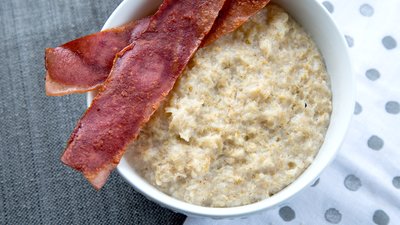When you're transforming your physique, you need lots of protein first thing in the morning. We all get stuck in ruts and equate "breakfast protein" with eggs, maybe yogurt, maybe protein powder. Next time, instead of sticking with those same old breakfast standbys, get your protein from other sources. The following five selections will give your taste buds a break; they'll also do a better job of building muscle and helping you stay lean than carb-filled meals.[1,2] They can even help you feel more full for longer so you can avoid those empty snack calories.
1. Bring On the Smoked-Salmon Toast
Your morning slice of toast can be a platform for much more than just butter. To up your game—and your protein—lay on some delicious smoked salmon to get about 17 grams of protein in a single-ounce serving. The salmon will also provide a good dose of heart-healthy omega-3 fatty acids, something many of us don't get enough of.
Recent evidence suggests that higher intakes of omega-3s can promote a greater diversity of beneficial bacteria in your gut. These extra microbes can have wide-ranging health benefits, from promoting normal digestive functioning to supporting a healthy immune system.[3]
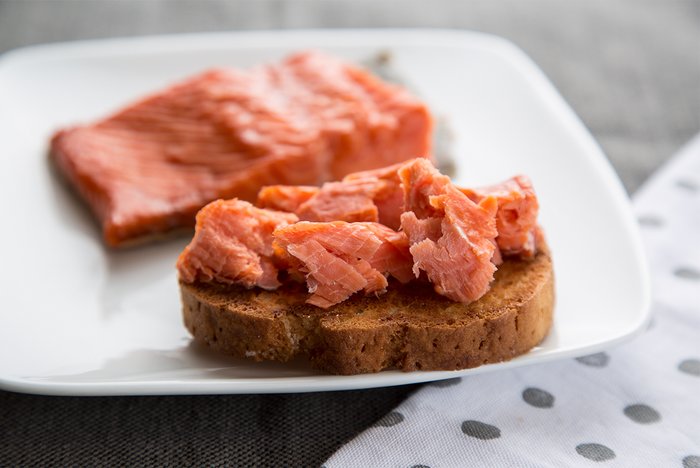
For a meatier texture, look for whole smoked-salmon fillets instead of the more common thinly sliced variety. If you want to start off your day with a taste explosion, stir together whipped cream cheese, honey, minced fresh ginger, and lemon zest. Spread this mixture on toasted whole-grain bread and top with chunks of smoked salmon and chopped chives.
2. Change Up Cold Cereal With Hemp Seeds
Cereal is handy, but out of the box, it's not exactly what you might call a protein powerhouse. Adding milk helps, but you can easily bump up the protein count by sprinkling on hemp seeds. Also called hemp hearts, these nutty-tasting seeds provide about 6 grams of protein in a 2-tablespoon serving.
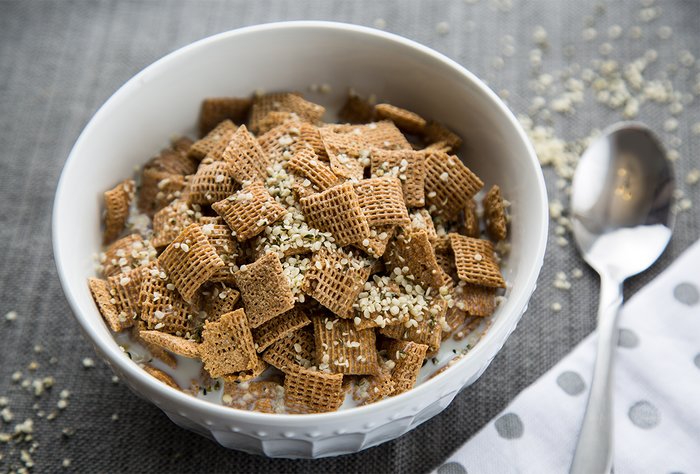
Hemp also contains a full arsenal of the essential amino acids your muscles crave. As a nutritional perk, they also supply notable amounts of omega fatty acids and magnesium, a mineral linked to promoting normal cardiovascular health.[4] Researchers have discovered that the amount of protein found in hemp far exceeds the amounts found in other plant foods, such as grains, nuts, and legumes.[5]
3. Top Your Oatmeal With Turkey Bacon
Cooked oats are yet another great way to start the day. You can make them even better by topping off your bowl with pieces of crispy turkey bacon. Generally lower in fat calories than its piggy counterpart, turkey bacon will add about 3 extra grams of muscle-building protein per slice, as well as some bone-friendly phosphorus.
For a surprisingly tasty morning meal, add chopped walnuts, apple, or pear to the bacon. Or go savory by adding sliced sun-dried tomato and shaved parmesan.
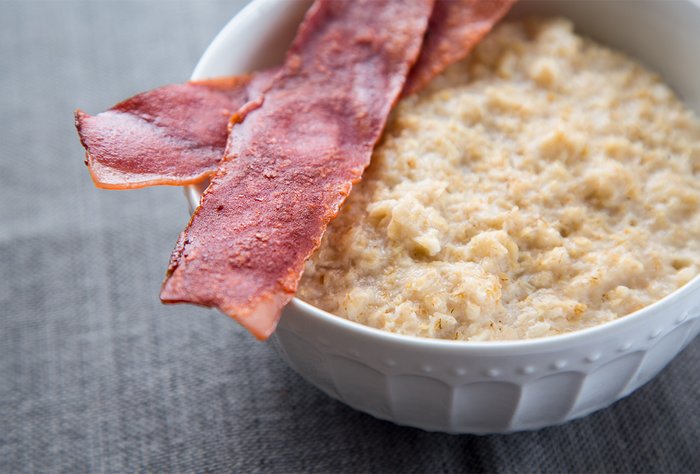
You don't even need to break out the frying pan and splatter shield to cook the bacon. Sandwich a few turkey bacon slices between layers of paper towel and place on a microwave-safe plate. Microwave the bacon on high for about 1 minute per slice. Turkey bacon can dry out faster than regular bacon, so check it often to make sure it reaches the right consistency.
Once the bacon is done, let it rest a couple minutes to crisp up. Read your nutrition labels to find out which turkey bacon brands have the lowest amounts of sodium.
4. Make Eggs Dishes Spectacular With Goat Cheese
A touch of tangy goat cheese can transform basic scrambled eggs into a creamy delight that you'll want to jump out of bed for. A nice bonus is the 5 grams of high-quality dairy protein each ounce of the cheese adds to the already protein-rich eggs. And because soft goat cheese contains more moisture than hard cheeses like cheddar, it tends to be less calorie dense. Simply stir some crumbled soft goat cheese and chopped herbs into beaten eggs and cook in a skillet, stirring frequently. This dish is suitable for any meal.
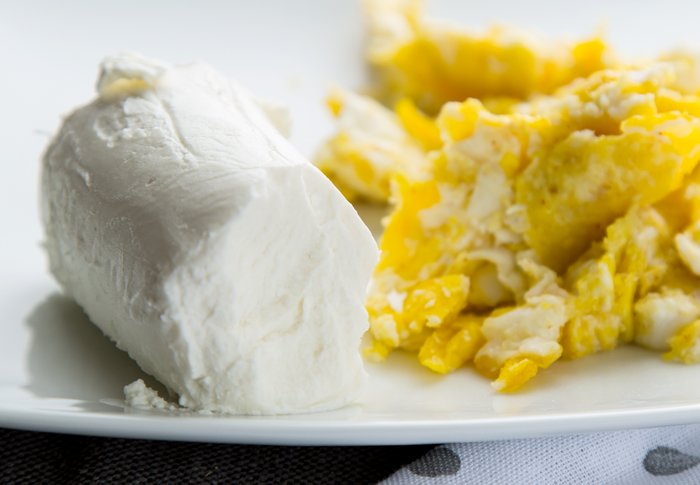
5. Put Peanut Butter in Your Pancakes
A stack of pancakes can be a weekend treat, but since they're made up of mostly flour and maple syrup, they're pretty much a carb bomb. Trade in some of those carbs for protein by replacing wheat flour with peanut butter powder. The powder is made by squeezing the oils out of roasted peanuts, then grinding them into a nutty flour. The finished product adds about 6 grams of protein per 2-tablespoon serving.
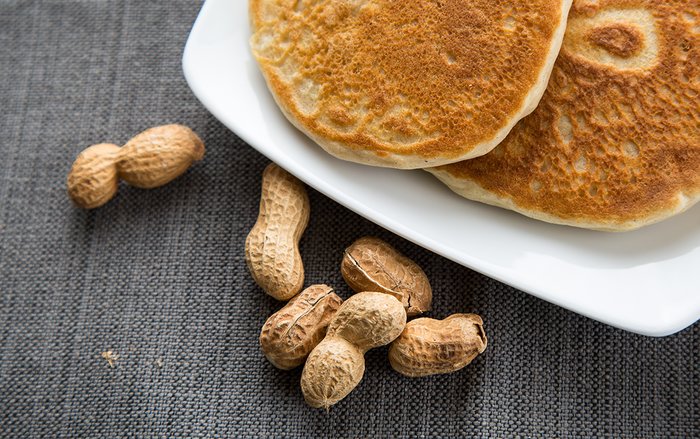
Replace a quarter of the regular flour you use with peanut butter powder, or use the powder to make a delicious flapjack topping. For the topping, place 2-3 tablespoons of peanut butter powder in a small bowl and whisk in milk, 1 tablespoon at a time, until you reach the desired consistency. For added flavor, add some cinnamon and vanilla extract to the topping. A great way to start any day!
References
- Leidy, H. J., Gwin, J. A., Roenfeldt, C. A., Zino, A. Z., & Shafer, R. S. (2016). Evaluating the intervention-based evidence surrounding the causal role of breakfast on markers of weight management, with specific focus on breakfast composition and size. Advances in Nutrition: An International Review Journal, 7(3), 563S-575S.
- Leidy, H. J., Tang, M., Armstrong, C. L., Martin, C. B., & Campbell, W. W. (2011). The effects of consuming frequent, higher protein meals on appetite and satiety during weight loss in overweight/obese men. Obesity, 19(4), 818-824.
- Menni, C., Zierer, J., Pallister, T., Jackson, M. A., Long, T., Mohney, R. P., ... & Valdes, A. M. (2017). Omega-3 fatty acids correlate with gut microbiome diversity and production of N-carbamylglutamate in middle aged and elderly women. Scientific Reports, 7(1), 11079.
- Kass, L., Weekes, J., & Carpenter, L. (2012). Effect of magnesium supplementation on blood pressure: a meta-analysis. European Journal of Clinical Nutrition, 66(4), 411.
- House, J. D., Neufeld, J., & Leson, G. (2010). Evaluating the quality of protein from hemp seed (Cannabis sativa L.) products through the use of the protein digestibility-corrected amino acid score method. Journal of Agricultural and Food Chemistry, 58(22), 11801-11807.



